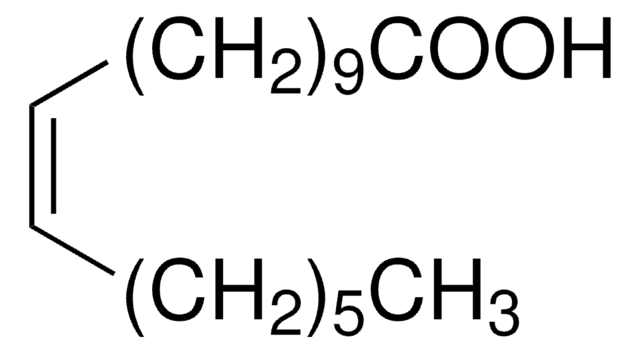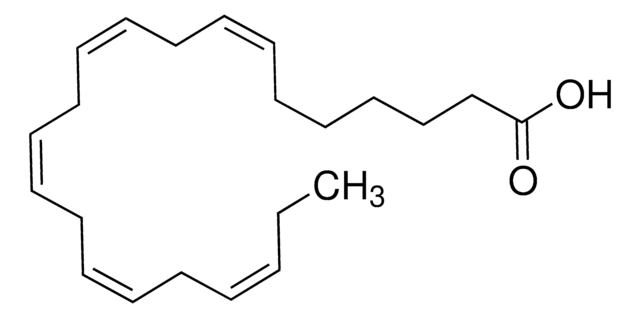69301
cis-Vaccenic acid
analytical standard
Sinônimo(s):
octadec-11(cis)-enoic acid, cis-11-Octadecenoic acid
About This Item
Produtos recomendados
grau
analytical standard
Ensaio
≥97.0% (HPLC)
forma
liquid
prazo de validade
limited shelf life, expiry date on the label
Impurezas
≤0.5% trans-isomer
índice de refração
n20/D 1.459 (lit.)
pb
150 °C/0.03 mmHg (lit.)
pf
14-15 °C (lit.)
densidade
0.887 g/mL at 25 °C (lit.)
aplicação(ões)
clinical testing
temperatura de armazenamento
−20°C
cadeia de caracteres SMILES
CCCCCC\C=C/CCCCCCCCCC(O)=O
InChI
1S/C18H34O2/c1-2-3-4-5-6-7-8-9-10-11-12-13-14-15-16-17-18(19)20/h7-8H,2-6,9-17H2,1H3,(H,19,20)/b8-7-
chave InChI
UWHZIFQPPBDJPM-FPLPWBNLSA-N
Procurando produtos similares? Visita Guia de comparação de produtos
Descrição geral
Aplicação
- Quantification of the analyte and its photodegradation products in marine samples using gas chromatography coupled to electron impact mass spectrometry (GC-EIMS). The photo-oxidation of the lipid components of the two strains of aerobic photoheterotrophic bacteria, Erythrobacter sp. strain NAP1 and Roseobacter-related isolate COL2P is studied and the results obtained after irradiation of axenic and nonaxenic cultures of the diatom, Skeletonema costatum is compared.
- Quantification of the analyte in the methanolic extract of the leaves of Lepidium sativum using gas chromatography coupled to mass spectrometry (GC-MS).
- Quantification of the analyte in methanolic extract of Rosmarinus oficinalis leaves using gas chromatography coupled to mass spectrometry and Fourier transform infrared spectroscopy.
Produtos recomendados
Código de classe de armazenamento
10 - Combustible liquids
Classe de risco de água (WGK)
WGK 3
Ponto de fulgor (°F)
446.0 °F - closed cup
Ponto de fulgor (°C)
230 °C - closed cup
Escolha uma das versões mais recentes:
Já possui este produto?
Encontre a documentação dos produtos que você adquiriu recentemente na biblioteca de documentos.
Nossa equipe de cientistas tem experiência em todas as áreas de pesquisa, incluindo Life Sciences, ciência de materiais, síntese química, cromatografia, química analítica e muitas outras.
Entre em contato com a assistência técnica







